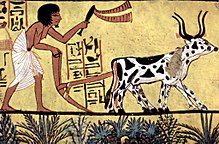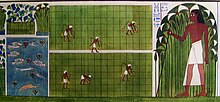Agriculture in ancient Egypt

The agriculture in ancient Egypt was long regarded as the nucleus of Agriculture and one of the origins of human civilization in general. This view was supported by popularized descriptions from the Bible .
Biblical traditions
The 1st book of Moses tells of Joseph , who stood out as interpreting dreams in prison and also interpreted the dreams of the Pharaoh . This Josef finally becomes a successful trader: In seven profitable years he collects all grain stores in granaries. When a drought set in, Joseph sold the grain he had collected to the Egyptians. Then he exchanges grain for cattle, later for land of the Egyptians, and in the end the farmers become serfs of Pharaoh. He introduces a law that the Egyptians should continue to cultivate the field, but in return they should pay 20% of the yield to the Pharaoh.
These biblical narratives had a great influence on the ideas of ancient Egypt in Christian states . Since the 18th century, the Bible has been perceived and studied as a book that has grown over time.
State of research
Until the exploration of the Mesopotamia by archeology , Egypt was "even the oldest" center and thus also the origin of human civilizations. In fact, as early as 3000 BC there were BC Granary in Egypt. The very fertile Nile mud represented an important basis of Egyptian agriculture, as it had an essential fertilizer function due to its nutrient content and made the land on the Nile fertile. The Austrian biologist Annie Francé-Harrar wrote in 1950: “It is really only the 'shovel of humus', thrown into the bare sand of the desert, which that ancient 'Urnile' furrowed.” The missing forests were made up by artificial planting with the mulberry- Fig (sycamore) replaced.
The natural water flow of the Nile was shaped by the flood from June. The beginning of the year on the Egyptian calendar was also aligned with the onset of the Nile inundation from the earliest times. The flood of the Nile is predictable and always occurs at the same time of year; the beginning and end can be postponed by a few days. The decisive factor is the amount of water, which has a major impact on agriculture. The Nile level rose near Aswan from June and reached its peak in August, the tidal wave reached the Nile delta about two weeks later. Herodotus reports that the flood of the Nile began at the time of the summer solstice - that was in his time in the 5th century BC. Around the 22./23. June. The season of the flood was called Achet in the Egyptian calendar . The sowing took place immediately afterwards on the soaked soil, the harvest could and had to be done after around three months before the summer heat set in. In ancient times, wheat, vines and olive trees were grown in the Mediterranean region , combined with livestock farming in the heavily deforested mountains. Then there was fruit and vegetable growing .
Leonid Grinin , who is considered to be the proponent of the theory of the Neolithic Revolution , assumes that the first cultivation of grain also took place in ancient Egypt.
The quoted account of dream interpretations in the Bible can be seen in connection with various ancient Egyptian texts. This is how King Merikare interpreted around 2170 BC. The dream as an indication of future events. A list of 200 dream interpretations has come down to us from the time of the Middle Kingdom .
Seasonal irrigation
The Egyptians developed an irrigation system to bridge the dry spells. Initially, small trenches were created to the individual gardens. Later, the agricultural areas were divided into flood basins, each of which could be 2 to 200 km² in size. They were surrounded by dams and equipped with inflow and outflow channels. The basins were flooded once a year at the time of the highest water level of the Nile flood and then closed for about six weeks so that the mud could settle and the soil could be moistened. The remaining water was then drained into neighboring, lower lying basins and into the Nile, which was already falling again. The seeds were sown immediately after the basins were drained. Some representations suggest that fishing was also carried out.
Individual evidence
- ^ A b Hans Joachim Störig: World History of Science , Volume 1: Natural and human sciences from antiquity to the 18th century. Weltbild Verlag, Augsburg 1992, page 57
- ↑ see Gen 40,2 EU and following
- ↑ see Gen 41.1 EU and following
- ↑ From agriculture to cogwheel - 7000 years of early technical culture , text and chapter introductions by Hannsferdinand Döbler , rororo paperback edition 1969, volume 1, page 40
- ↑ a b Annie Francé-Harrar: The last chance for a future without need , Munich 1950, according to reprint 2007 on page 320 f.
- ↑ Herodotus, Historien 2nd book, 19
- ↑ Grinin LE Production Revolutions and Periodization of History: A Comparative and Theoretic-mathematical Approach. / Social Evolution & History. Volume 6, Number 2 / September 2007 [1]
- ↑ Dream and Dream Interpretation , book from the series "Secrets of the Unknown", TIME-LIFE, 4th German edition 1993, page 26.

